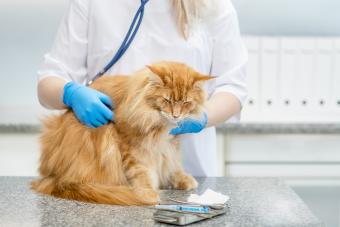
Cats and the sun go together like peanut butter and jelly. If there's a patch of sun somewhere, you're sure to find a cat sprawled out in it. But this phenomenon can make owners wonder if their cat can get sunburned. Yes, cats (even indoor cats) can experience sun damage if they're in the sun for too long. Find out if your cat is at risk, along with ways to protect your kitty so they can still enjoy the sun without getting burned.
How to Protect Your Cat from Sun Damage
Fortunately, cat sunburns are preventable. Take these precautions to protect your feline friend.
- Keep outdoor cats inside between the hours of 10 a.m. and 4 p.m. when the sun is the strongest.
- Place UV protective window film on windows to protect indoor cats.
- Use a cat-safe sunscreen on vulnerable areas like their ears and nose.
Do not use suncreen made for humans on your cat because it could be harmful to them. Also, just like with people, you need to reapply sunscreen on your cat periodically to keep them protected.
Cats Get Sunburn Differently
While cats do get damanged by exposure to sunlight, their sunburns are a little different from ours. You generally won't see the immediate effects of the sun on a cat like you would on your own skin after laying out. Instead, the effects are cumulative, so you'll see signs after repeated sun damage over months or even years. This is called solar dermatitis in cats.
Can indoor cats get a sunburn through the window? Unfortunately, yes. The sun can still damage your cat's skin, even through glass.
Signs of Sunburn in Cats
How can you tell if your cat has a sunburn? It can be a little tricky to see because of their fur, but you might see these cat sunburn signs right after sun exposure or in the weeks or months afterward.
- Pink, inflamed skin
- Scaley, crusted skin
- Thickened skin
- Blisters or bleeding
- Hair loss
- Pawing or scratching at area
- Signs of pain
The most common areas you'll see sun damage and sunburn on cats are the ears, nose, lips, and eyelids.
Most Susceptible Cats
Really any cat can get a sunburn, but some are at a much higher risk. This can depend on their physical characteristics, like their coloring or their environment. Cats most likely to get a sunburn are:
- White cats
- Cats with pink skin
- Cats with non-pigmented skin
- Bicolor and tricolor cats with white fur
- Hairless cats
- Outdoor cats
Hairless cat breeds like the Sphynx are especially vulnerable to sun exposure. They really need to live as indoor cats and you should take extra care when they're exposed to sun.

Consequences of Sunburn in Cats
Sunburns aren't just uncomfortable for cats; they can also lead to skin cancer. Squamous cell carcinoma (SCC) is the most common type of skin cancer cats develop due to sun exposure. The areas need to be surgically removed, which is why you often see pictures of white cats with amputated ears. White cats are 13.4 times more likely to get SCC than cats of other colors.
Cats Can Safely Enjoy the Sun
It can be hard to keep your sun-loving cat out of the rays. Fortunately, you don't have to. With UV-blocking products like window films and sunscreen, you can keep your cat safe from sun damage. And if you do notice any symptoms of solar dermatitis, don't hesitate to have your vet check it out. Early detection is the key to the best outcome.







